I had originally thought of using a dip in the ground west of Cloud Pavilion (one of our rain-barns) to create a small pond, fed by water from the storage tanks at Cloud. Cloud was so that 4 2500 gallon tanks could be placed in it (under the two upper decks) but on further consideration (and R-‘s discovery of both heart problem & cancer) that big plan was dumped. We have 5000 gallons of storage installed at Cloud (though we did not foresee, silly people we are, that the tanks with water in them would try to sink in the ground every time we had a wet year…the outlet fixture is presently about six inches down. Duh.) When the creek still mostly had at least some puddles in it, we used the water for “drip pans” that served small small animals–reptiles like snakes as well as small mammals, and also some birds. But the creek’s been essentially dry for several years now–time to step up the water service for wildlife.
I like to create naturalistic (not fully naturalized because that’s expensive and difficult) water features that appeal to birds, mammals, reptiles, amphibians, and invertebrates, offering a chance to reproduce to some that need a wet spot, or underwater for their nymphs for instance…which also provides another food source for other critters. We’ve discovered that wildlife can and will eventually make holes in the toughest pond liners, but it takes them longer with a thick-enough plastic or rubber tub-like thing. Water containers designed for cattle or horses are above ground (so not subject to the chemical attacks of various soils) and usually 1-2 feet deep. Wildlife prefer water lower than that, though some will drink from livestock waterers (black vultures will foul a standard 100-200 gallon water trough by standing on the edge to drink then turning around and pooping in it. Yuck.) Critters that fall into deep water can’t climb out a vertical wall (some can; it’s the ones you find rotting in your water trough that can’t. Very Yuck.) So designing for multi-species use…and their ability to get out safely…places constraints. Critters like armadillos and small rodents want a ground-level access to water–while raccoons can stand up on their high legs and drink from some higher sources, ‘dillo hind legs don’t give them that flexibility. So…ground level access. Deep parts of the system help regulate water temperature, but are dangerous for some so…provide a route out (board, sticks, rocks more climbable than rubber/plastic walls.) Birds want bathing places as well as drinking places; some birds always arrive in flocks and need more space (flocks of robins, cedar waxwings, and individual large birds like the Cooper’s hawk we had last year.)
Back to this project. a 40-50 gallon oval tub, to be sunk into the ground as the base pool. When this is finished, a solar-powered pump will go in it. A shallower, smaller pool to be placed above and pouring into the bigger tub–if too deep, to be filled at least partially with gravel or sand to provide the shallow water small birds need for bathing. Today was placing, and digging the hole for, the lower tub. I didn’t have the camera along on the first trip, so had to go back and get it, so there aren’t any pictures of deciding where to put it. Wanted to be able to see wildlife at the water from Cloud, both upper platforms and down in the shade. The first image shows the placement (inside that ring of dirt that came out of the hole) as seen from inside Cloud.
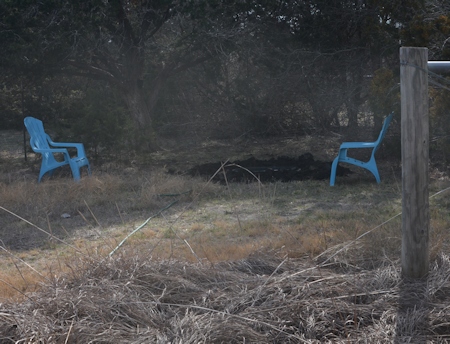
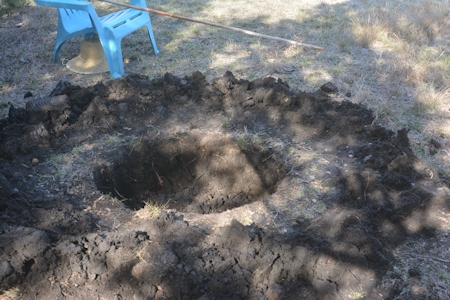 The hole
The hole

The tub fits into the hole and is just enough above true ground level that runoff from the field to (there’s a slight channel through here) won’t just fill the tub with dirt over time. The dirt removed will be carefully backfilled and formed into a low-angle berm that will allow the wildlife to come up to the lip of the tub easily…and they will also have the shallower upper pool if they want. It will be supported on pavers, most likely. We will also plant some attractive food plants nearby (firecracker bushes to attract hummingbirds, elbowbush for deer and birds and–in spring–native bees and other pollen eaters, and water those for the first years.
The Chief Digger (I dug some but he did more) surveys his work, then takes a rest: it was in the 80s today.
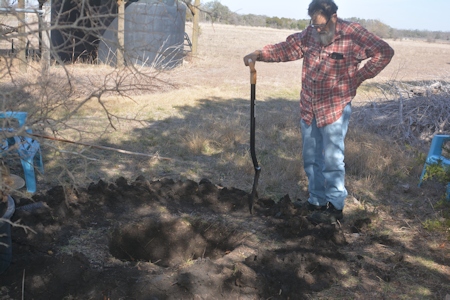
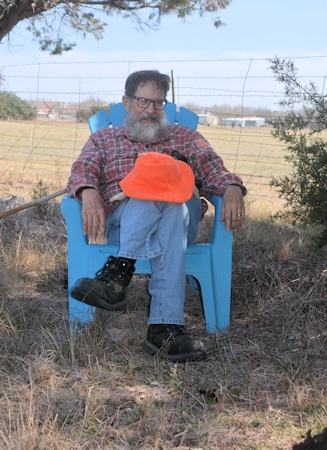
Addition: Friday the 13th of January. I went out in the mid-late morning with a heavy metal rake to see if I could level the bottom of the hole (or if it had leveled itself with the tub dropped into the gloppy mud the night before. Pulled the tub out; only one small area on the bottom was wet, and the bottom was still uneven. I tried raking int (an oval hole is hard to rake with that rake) and got it level-er. Wet it down a little, raked the still dry bits into the wet glop, tried again. Put the tub in, thumped the bottom…not supported. Rinse and repeat several times. Threw clods in to melt them and help level the bottom. Finally got the bottom so the tub didn’t have large hollows under it (different sound and feel when thumping the tub bottom with the end of the rake handle.) I moved quite a big of soil round–fraction of what we dug out, but still it was all hand work, crumbling clods and feeding them into the cracks. that’s not all done yet, BTW.
Water in the tub! Started filling the tub with water to weight it down while I added looser & smaller lumps to the gaps at the sides and “melted” them so they’d go on down. R- appeared from the other chores he’d been doing and said the tub was too low now (he’s sortakinda right, BUT I wanted to see water filling the tub to get an idea of how that would look. Yes, it’s for wildlife but it’s also for me to enjoy the look of.) I did not want to lug a partly full tub out of the hole, waste that water, try to fill the hole a little more, and keep fitting and re-fitting right then. Hmmph. I had at least a pound of mud stuck to my rubber boots (yes, I had that much sense) and can now state clearly that a hoe that’s been used for mixing concrete is not the best of tools to scrape mud off boots with. Awkward is the kindest thing you can say about it.
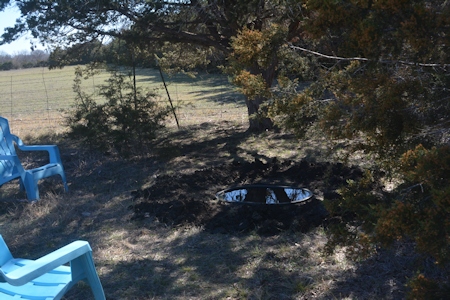 View to the south, across/through fence at line of creek woods. Two blue chairs are plastic,
View to the south, across/through fence at line of creek woods. Two blue chairs are plastic,

This pic is looking north-ish at the dry woods across the West Grass, showing the corner of Cloud, part of its east upper deck and the two storage tanks.
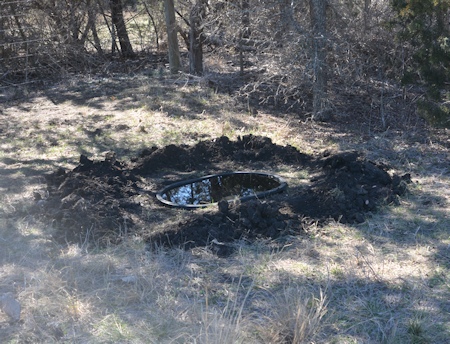 If you’re experienced at following signs of fences, you can see the line of our south fence (and neighbor’s older fence in upper LH corner. There’s a patch of brushy stuff on our side of the fence and Cloud Water is positioned to get afternoon shade in summer from it, while the nearby brush allows birds & others some cover when they come for water. On the other side, but farther away from the water, is a brushpile where birds often shelter. We make brushpiles for shelter whenever we trim things up.
If you’re experienced at following signs of fences, you can see the line of our south fence (and neighbor’s older fence in upper LH corner. There’s a patch of brushy stuff on our side of the fence and Cloud Water is positioned to get afternoon shade in summer from it, while the nearby brush allows birds & others some cover when they come for water. On the other side, but farther away from the water, is a brushpile where birds often shelter. We make brushpiles for shelter whenever we trim things up.
Then we both decided (sitting down) that it was beautiful–the sky reflected in it, the trees and bushes around and so on. R- remembered where he had a length of PVC pipe we could put into the tub as an escape route (not ideal, ugly, but they do work…for now. So we put that in. Anyone who’s had to fish a dead & decomposing critter out of a stock tank or bathtub put out to water horses knows that a float and a ramp are essential…unless you like the smelly and slimy task. When I got back to the house and had had a rest for an hour, I realized I should’ve put out one of the shallow plastic pans we’d used before, that birds could bathe in. So, after haying the horses, I walked back out to Cloud and dipped out some water and there it was. (Didn’t take the camera in late afternoon on that trip.) I am a wee bit tired.

“though we did not foresee, silly people we are, that the tanks with water in them would try to sink in the ground every time we had a wet year…the outlet fixture is presently about six inches down. Duh”
My Dad, a fervent DiY farmer and “smarter than everyone else” failed to consider we had a hard clay layer over a liquifying substrate, despite having had a horse go hock-deep on the other side of a barn. Just dug postholes, no concrete footings.
Came out one morning to find about HALF the posts supporting a 5000g tank had sunk deeply. Frame of course split and tank now draped unfixably over the top.
This is really very cool!!! Great ideas.
Amazing love for your land and its wildlife.
My late father made a couple of ponds like that for wildlife in his woods. He also made some large fishing lakes, but that’s another story (he liked messing about with JCBs). But the little wildlife ponds were very successful. Another group made a traditional dewpond on one of our local downs, but I’m not sure how well it worked. The only time I saw it, it looked rather pathetic.
When I lived on a farm in Parker County, we had a metal water tank with a float valve to water the cattle. A squirrel fell in and drowned, so my dad started putting a tree branch or even a wooden tool handle slantwise in the tank, to provide a way for varmints to climb out instead of drowning.
Yup,that’s what the PVC pipe is for. It will be replaced by something more natural looking when we find the right thing. We’re supposed to get some rain this weekend, and will be watching to see if it tries to sink into the ground.
Someone looks kind of tired – both of you, don’t over stress yourselves.
Have a good three day weekend.
I was tired from missing sleep; R-‘s tired from working on the land, but it’s satisfying. Kind of have to have the one to have the other. We don’t make much change through the week, except church on Sunday. Self-employed it’s easy not to have a day off.
“Wee bit tired” she says… I’m exhausted just reading about your day. Hope it was the tired that helped you sleep well and not the tired that leaves painful muscles that keep you awake.
Not being kept awake…I hit the sack and usually go under very quickly. But I do wake up again most nights, both for the usual physiological reasons and “busy brain” that naps and then says “You know if you had X do Y, and then R could square the circle and…” at which point I read for awhile to shut it up, then go back to sleep.
I had a woodshed to get rid of 30 years ago when some giant white pines threatened the house and power lines. Electric Co. cut them down and I cut them up. Turned out to be the perfect place to dig a decorative/wildlife pond. Used butyl rubber to line it. Many kinds of stone have been used around it over the years and one side has a “bog garden” just below the top edge. Pitcher plants, iris, azalea. Nothing has ever been killed in it as there are overarching bog plants to grab. Also have one side which is a slope of flat rocks which can be climbed/hopped etc. And it is covered with ice for about 4 mo. each year.
Frogs are the chief inhabitants, 4 varieties, plus butterflies, dragonflies, birds etc. Also have a small river at a lower elevation, (would be a creek in Texas) with a swimming hole (waist deep but fast), and waterfall/cascade. Tempting for beavers but the last one seems to have realized that his predecessors ate all the alders. For 30 years I had just the frog pond, but could not resist the “Falls River” and the swimming hole when it was up for sale.
Do you have flat rocks for edging? I have natural slate and glacial deposits. At times I have also surrounded it with ground covers like creeping jenny etc. Dare say Texas doesn’t have much in the way of moss etc.
Anyway, good luck. And take care.
That sounds wonderful, magical, and I totally get buying the land with the river and a waterfall cascade…so happy you have that!!